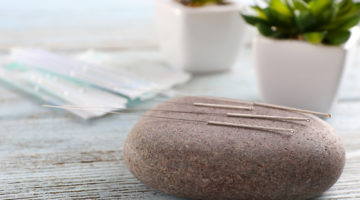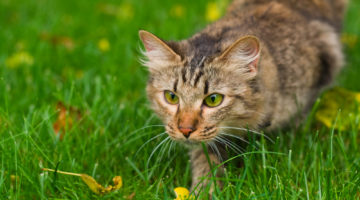The act of predation is a key part of the feline digestive process, and without it, your kitty may not absorb nutrients from food as readily as he should. Offered every four or five days, this acupressure session can help enhance his digestion.
Our sweet little housecats are also killers. Given the chance, they’ll stalk, attack and devour mice, birds and other small critters. Anatomically, they’re no different than their predatory ancestors, who were charged with keeping ancient Egyptian grain storehouses free of vermin.
The Egyptians gave small cats the big job of rodent control because of their amazing hunting ability in low light. Cats can see the slightest flicker of movement and instantly pounce before any little creatures can skitter away. In short, they have survived on freshly killed prey for centuries. In fact, the feline gastrointestinal system is perfectly designed for ingesting raw meat and breaking it down into bio-absorbable nutrients.
Even today, some felines are gainfully employed as barn cats. They are expected to annihilate and consume any fast-moving little varmints that dare trespass with the intent of consuming grain or seeking warmth in hay. However, in our society, most domesticated cats live as pampered gentry in our homes.
Predatory drive aids digestion
As cat parents, most of us would prefer not to replicate or condone the feline hunting instinct. We want to forget that our cats are killers by nature. However, this attitude may make it
difficult for our cats’ digestive systems to work as well as their wild counterparts’. It’s actually their predatory drive that begins the digestive process – in other words, feline digestion begins even before the prey is ripped apart and masticated by sharp incisors, premolars and molars!
The cat’s digestive enzymes and stomach acid are actually stimulated by the act of predation, in preparation for the meat and blood to enter his mouth, travel down his esophagus to his stomach, and pass through his entire gastrointestinal system. Because domestic cats have to skip the predation phase of their digestion, their natural manner of consuming and processing food is compromised right from the start.
Cats are protein-obligate predatory animals. Their bodies function best if they consume high quality proteins with little grain or plant matter. For instance, think of a cat catching a field mouse for his first meal of the day. He usually consumes the entire mouse (minus the liver), including the stomach contents. The quantity of grain and plant matter in the mouse’s stomach is just about all the cat needs from a nutritional perspective. The mouse’s size provides a good start to the cat’s daily protein requirement.
Very few of us would be comfortable making live rodents available for our cats to kill. And though cats are amazingly adaptable to our way of life, this doesn’t mean we can ignore their nutritional needs if we want them to live long, healthy lives. About the closest we can come to fulfilling a cat’s natural nutritional needs is to feed a raw meat and fish diet – but again, putting a meal in a bowl, no matter how healthy it is, still excludes the predation process and may have an effect on the cat’s digestion and nutrient absorption.
Another factor affecting your cat’s digestion is his age. When he’s young, his body can manage on what you make available for him to eat. As he ages, his digestive system tends to slow down and may not be able to derive the necessary nutrients to maintain a vital body.
Given that we don’t offer live “bait” to our feline companions, and have no way to keep them eternally young, it’s a good idea to support their gastrointestinal tracts however we can. One way to do this is by offering a specific acupressure session (see below), every four or five days, to help enhance the digestive process. The more your cat’s body can readily process his food, the healthier he will be!
Digest This!
According to Traditional Chinese Medicine, energetic pathways or channels called meridians run through the body. Along these meridians are pools of energy we can stimulate to influence body function. These pools of energy are acupressure points, also called acupoints.
After years of clinical observation, TCM doctors have identified specific acupoints that aid digestion. These points enhance the functioning of the entire gastrointestinal tract, thereby helping to break down food substances into bio-absorbable nutrients.
1To generally enhance your cat’s digestion, put your middle finger on the tip of your pointer finger to make a little tent.
2At a 45° to 90° angle, gently place the soft tip of your pointer finger on an acupoint indicated in the chart. Acupoints are located just beneath the cat’s skin, so press lightly. Cats are very energetically connected; they feel everything. Your other hand can rest gently somewhere on your cat’s body.
3Count very slowly to 30 as you gently press an acupoint, then move to the next acupoint and repeat, placing your pointer on the acupoint and counting.
4Your cat has two sides and the acupoints are bilateral, too! Once you’ve completed the acupoints on one side, repeat the same procedure on the opposite side.
5Of course, cats will be cats and you have to pay attention to his behavior. There’s no need to force the acupressure session. Most cats love it, but if yours is squirming, offer a session another day. An acupressure session is a dynamic interaction between you and your cat. He’ll come to understand that you are sharing this modality with him to help him feel his best.







No Comment